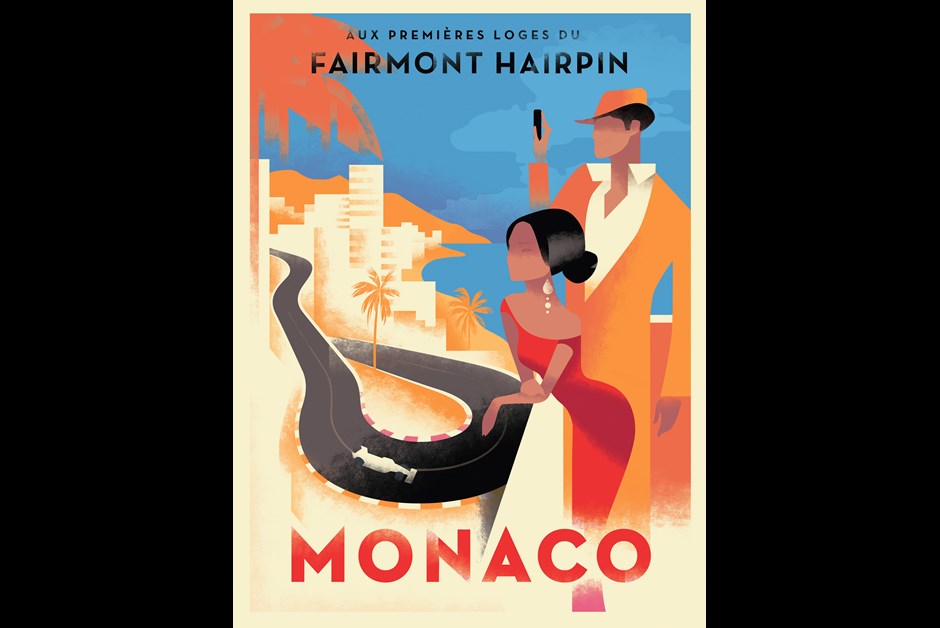Life in the Fast Lane
Life in the Fast Lane
When it comes to luxury, Formula One celebrations deliver at every turn. We take an in-depth look at the track-side action in Monaco – and make pit stops around the world.
By: Ellen Himelfarb
Illustrations by: Mads Berg
“Watch and learn,” says Jean-Jacques Yeterian as he flicks his Ferrari F430 Spider into first and steps on the gas. I’m thrown back into my seat and feel the salty air whip my hair. As we hurl along Monaco’s Basse Corniche – the marina to our right, prime real estate to our left – I put on my sunglasses and do my best Grace Kelly. It’s no use trying to catch the names of the mega-yachts in their berths. They’re all a blur.
Yeterian points out more sites as we climb the palm-studded coastline toward the legendary casino: the new Monaco Yacht Club, styled like a grand Art Deco ship; the baroque Opera House, where Princess Grace hobnobbed with Maria Callas; the fabled hairpin turn that swerves past the Fairmont Monte Carlo’s foyer. I’m so revved up by the whirr of the engine that when Yeterian – whose high-speed tour comes care of Jean-Marc Ayache’s Driving Experience – invites me to take the wheel, I nearly jump into his lap.
Monaco and sports cars are inextricably linked, dating back to the principality’s first Grand Prix in 1929. The circuit has been part of the Formula One championship since the ’40s, around the time Ferrari first came into the picture. Because of the rocky ledges and sharp, demanding turns of the city streets, Monaco is considered one of the top courses in auto racing. As even David Coulthard, the 13-time Grand Prix champion and Monaco resident, tells me, “Monaco is worth 25 points, like any other F1 race, but it’s the one on the calendar for any driver.”
Seeing it from behind the wheel of a Ferrari is a luxurious experience for any racing fan. And for a Ferrari naïve like myself, the tour delivers. After our lap of the official circuit (racers do 78),
we head into the hills. I take the wheel just outside Monaco’s borders and within minutes I’m veering precariously close to the precipice, accelerating like a pro. And it appears I’m not alone.
Lamborghinis and Porsches fill the streets with the roar of engines and the smell of oil. The rumble “is, to me, like music,” says my Monegasque friend Claudia.
In Monaco the wave of the checkered flag is like the clock striking 12 on New Year’s Eve. Yet while the F1 props up the tourist calendar in a major way, it is not, my friend assures me, even close to all that Monaco has to offer. Of course, I’ve known that since my days as a student in nearby Nice, having a crack at the slot machines, falling asleep on the steps of the silvery-brick cathedral in wait of the first train back. As we chat over yellowtail sashimi at Nobu, she fills me in on the latest.
Nobu, probably the finest of Monaco’s new generation of restaurants, is on the Fairmont’s main floor. Then, up the steep rock face, between the art nouveau Café de Paris and the sexy Buddha Bar, are the Pavilions, a cluster of amorphous white pods housing boutiques like Alexander McQueen, Lanvin and Saint Laurent. The mini shopping center was built as a temporary substitute for an even posher plaza being built further east. But the curious architecture has proven to be a draw, and my friend tells me they’ll keep it around. “In Monaco, they don’t destroy, they just build.”
Bidding my Ferrari farewell, I stroll toward Larvotto Beach to Villa Sauber, one of two restored stucco manors that make up the Nouveau Musée National de Monaco (the other is in the hills above Port de Fontvieille),
spearheaded by Princess Caroline in a quest to bring cutting-edge contemporary art to the sovereign state. Sauber Villas’s exotic gardens of fig and orange trees lead up to the next clifftop, where I glimpse the city’s most recent build: Tour Odéon, a cobalt-blue glass monolith that promises more swish boutiques, restaurants and a penthouse apartment priced in the hundreds of millions.
With the crowning of Caroline’s brother Albert in 2005, his subsequent marriage and the recent birth of his twins, Monaco has entered the 21st century with a modern outlook and an openness to brew-pubs, architectural marvels and experimental food. Nowhere is the contrast between ancient and avant-garde more vivid than around the Rocher, the 450-foot-high outcropping where the Grimaldi family founded the principality more than 700 years ago. The palace’s medieval tower used to be the highest point in the land. Today the webbed white Simona Tower looms behind, a symbol of this new, progressive attitude.
A landscaped path smooth enough for high heels snakes down the Rocher to Port Hercule, where I peer into La Rascasse, a rowdy nightclub where VIPs party with a first-class view of the circuit. Then I duck into the pedestrian lanes behind for lunch at the revamped Marché de la Condamine, a Euro-style food court with heaps of fresh pasta, oven-fired pizzas and pyramids of chocolate truffles.
Further west, in Fontvieille, is the Prince’s Vintage Car Collection. Playboy no more, Albert opened this mindblowing assortment of automobiles to the public, including the 1954 Sunbeam Alpine his mother Grace drove in To Catch a Thief and a 1986 Lamborghini Countach with brazen scissor doors.
The “stay out” ropes will drive car nuts mad, but as I begin the walk back to my suite at Fairmont Monte Carlo, past tourists snapping at the palace guards, I console myself with memories of my dalliance with the F430. I may be a mere mortal, but I handled life in this fast lane like a champion.

